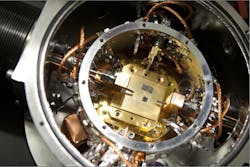Kinetic inductance produces negative refractive index as low as -700
Cambridge, MA--While "conventional" optical metamaterials can exhibit a negative index of refraction, it isn't any lower than the negative single digits. In contrast, researchers at the Harvard School of Engineering and Applied Sciences (SEAS), collaborating with the Weizmann Institute of Science in Israel, have now demonstrated a drastically new way of achieving negative refraction in a metamaterial that results in an "extraordinarily strong" negative index as large as -700.
"This work may bring the science and technology of negative refraction into an astoundingly miniaturized scale, confining the negatively refracting light into an area that is 10,000 times smaller than many previous negative-index metamaterials," says principal investigator Donhee Ham, Gordon McKay Professor of Electrical Engineering and Applied Physics at SEAS. The advance was reported in the August 2 issue of Nature.
Kinetic inductance arises from Newton's second law
The underlying physics of previous work in this field has often involved an entity called magnetic inductance. Ham's research group instead explored kinetic inductance, which is the manifestation of the acceleration of electrons subjected to electric fields, according to Newton's second law of motion.
The researchers' change in strategy from using magnetic inductance to kinetic inductance stems from a simple shift in ideas. "Magnetic inductance represents the tendency of the electromagnetic world to resist change according to Faraday's law," explains Ham. "Kinetic inductance, on the other hand, represents the reluctance to change in the mechanical world, according to Newton's law."
"When electrons are confined perfectly into two dimensions, kinetic inductance becomes much larger than magnetic inductance, and it is this very large two-dimensional kinetic inductance that is responsible for the very strong negative refraction we achieve," says lead author Hosang Yoon, a graduate student at SEAS. "The dimensionality profoundly affects the condensed-matter electron behaviors, and one of those is the kinetic inductance."
Semiconductor interface is where it happens
To obtain the large kinetic inductance, Ham and Yoon's work employs a 2D electron gas (2DEG), which forms at the interface of two semiconductors—gallium arsenide (GaAs) and aluminum gallium arsenide (AlGaAs). The very "clean" 2DEG sample used in this work was fabricated by coauthor Vladimir Umansky of the Weizmann Institute.
Ham's team sliced a sheet of 2DEG into an array of strips and used microwaves to accelerate electrons in the leftmost few strips. The resulting movements of electrons in these strips were "felt" by the neighboring strips to the right, where electrons are consequently accelerated. In this way, the proof-of-concept device propagates an effective wave to the right in a direction perpendicular to the strips, each of which acts as a kinetic inductor due to the electrons' acceleration therein. This effective wave proved to exhibit what the researchers call a "staggering" degree of negative refraction.
The primary advantages of the new technology are its ability to localize electromagnetic waves into ultrasubwavelength scales and its dramatically reduced size. This concept demonstrated with microwaves, if extended to other regions of the electromagnetic spectrum, may prove important for operating terahertz and photonic circuits far below their usual diffraction limit, and in the near-field. It may also one day lead to extremely high-magnification microscopes and new forms of optical tweezers.
Room temperature with graphene
For now, the device operates at temperatures below 20 K. The researchers note, however, that a similar result can be achieved at room temperature using radiation in the terahertz range, which Ham's team is already investigating, with the carbon structure graphene as an alternative 2D conductor.
"While electrons in graphene behave like massless particles, they still possess kinetic energy and can exhibit very large kinetic inductance in a non-Newtonian way," says Ham.
Kitty Y. M. Yeung, a graduate student in applied physics at SEAS, also contributed to the work as coauthor. The research was supported by the Air Force Office of Scientific Research.

John Wallace | Senior Technical Editor (1998-2022)
John Wallace was with Laser Focus World for nearly 25 years, retiring in late June 2022. He obtained a bachelor's degree in mechanical engineering and physics at Rutgers University and a master's in optical engineering at the University of Rochester. Before becoming an editor, John worked as an engineer at RCA, Exxon, Eastman Kodak, and GCA Corporation.
